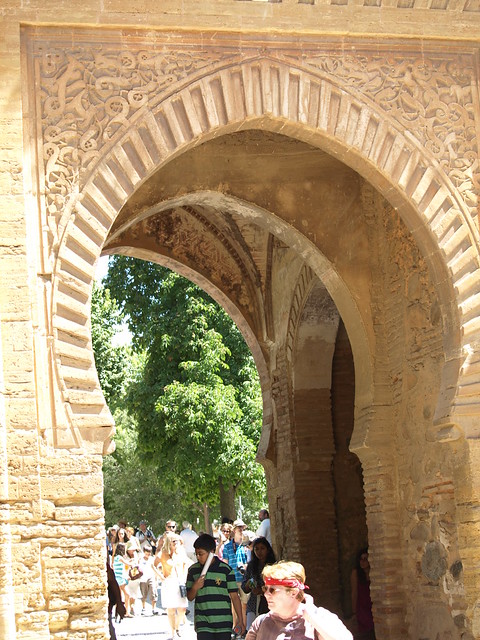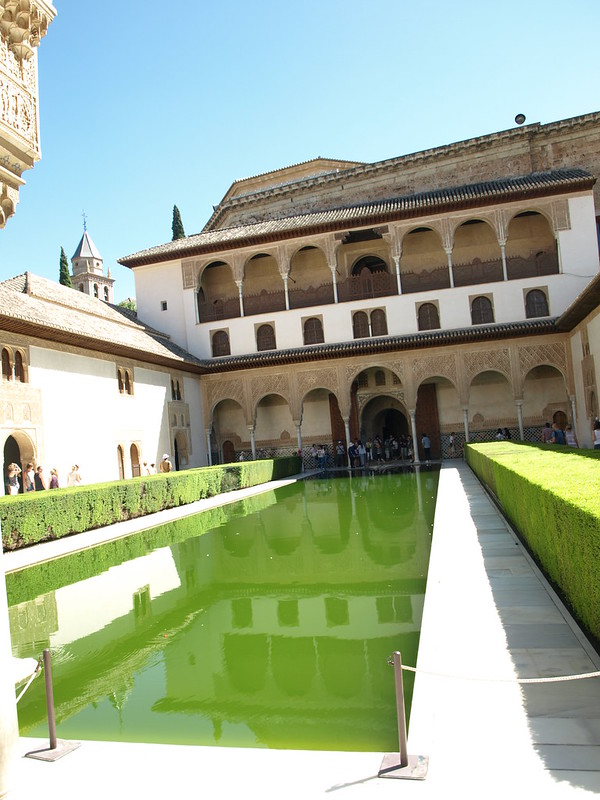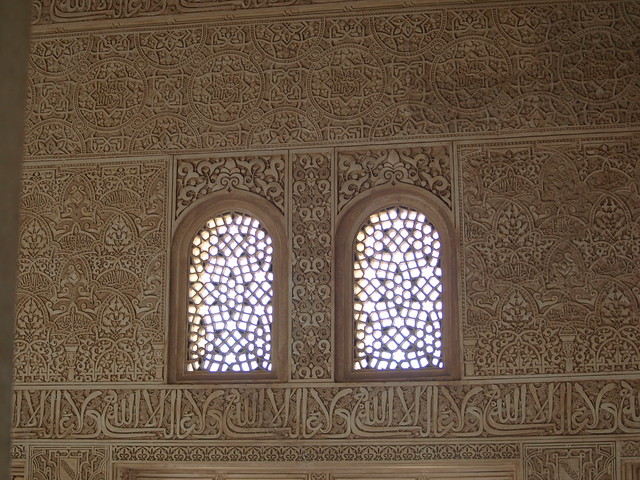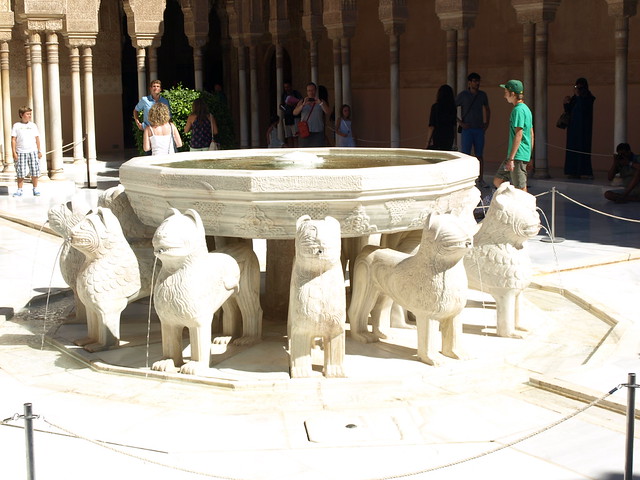"Give him a coin, women, for there is nothing worse in this life
than to be blind in Granada
http://www.flickr.com/photos/nasirgondal/sets/72157631361023114/
Granada it is, the ultimate tourist attraction in Spain. More than eight thousand tourists a day, and unless you have bought the ticket months in advance, you cannot see the Nasrid Palace. Yes it is the Nasrid Palace we mean when we say and speak of Alhambra. Not so big in size; in fact not big at all.
The beauty of Alhambra is not the size, on the contrary it is the economy of space. Moors knew they have not much space on the mountain top to make it big. The geometric illusions make it look a lot bigger than what it is.
And the water. "Alhambra is decorated with water: standing still, cascading, masking secret conversations, and drip-dropping playfully".
Spaniards were and still are fascinated by the legacy of Moors. They were believed to have power of the occult. There are stories of hidden treasures left by Moors with spell cast so that once the Moors come back, they can reclaim them. It is more or less what we grew up listening to the stories of hidden treasure buried somewhere in the houses and havelis Hindus left. It is perhaps the psychological impact of a race whom one always has apprehensions about and one builds myths about their unnatural powers and undue advantages.
All this is expressed the many tales and fables about Alhambra and its surroundings. Spaniards were really 'enchanted' by the beauty and the charm of the palace. They had to believe something magical about it. There are numerous tales, well archived by Washington Irving and the like, in Arabian Night style, about the Moors hiding in the caves, for centuries only waiting for the right time to strike back.
Most of these tales conveniently describe Moors as cunning and evil magicians, their women beautiful and wide eyed. They usually end with the victory of the good (Christians) over the evil (Moors). These are all fascinating stories and Irving has masterly narrated them.
There is a story of an astrologer Ibrahim ibn Abu Ayub, son of Abu Ayub Ansari, who mastered the art of living for ever, but only in his old age, so he has to live for ever as an old man.. He travels to Granada, then ruled by Tariq Bin Zayad's lieutenant Abu Hazen. The astrologer helps the king through magic to foresee the enemies and defeat them preemptively. Eventually the twain end up fighting with each other over a Christian princess and Ibrahim claims the prize by putting a spell on the princess and taking her along with him under the Gate of Justice. They will remain there until the hand carved in the Gate of Justice reaches the key inscribed into it. see below
Then there is the almost Saiful Malook like story of Prince Ahmed Kamal who is kept away from women right from the early life by his father as he was told that he will fall in love really badly. Kept in the tower of Generalife Gardens, he is told about love by a bird in love, a dove. He comes to know of a Christian princess Aldegonda in a far away land and is smitten with the unseen love. Then with the help of a wise Owl and a conniving Parrot he runs away and finds his way to Seville, Cordoba and ultimately to Toledo where he wins the hand of the princess in a Soyember like feast. King, the father of the princess, does not agree and Ahmed Kama runs away on a magical flying carpet attributed to the King of Kings, the fabled King Solomon. It all ends well when the king finds out on reaching Granada in revengeful pursuit that his daughter is now the sultana of Granada.
Then there is the story of Zayda, Zorayda, and Zorahayda, the three daughters of Al Hayzari, the Left Handed king of Granada. Their mother was a Christan princess who died soon after giving birth to the triplets. Al Hayzari was forewarned by sages that something will happen, so he kept them away from public eye as they grew up. The overprotective father was unaware that his daughters fell in love with three Castillian princes who were prisoners in Granada. In the end the girls plan to run away, by climbing down a rope out of the palace. The youngest one falters and is left behind. Her her soul still haunts the palace, until a Christian comes to rescue her and relive her desperate spirit from the eternal mourning. It is eventually done by a girl who is a descendant of the same prince who were to marry Zorahayda.
Then there are stories of ordinary men finding hidden treasures in Alhambra after striking a lucky charm here and there.
These stories inspired the treasure hunters to find and dig in various places; none has been found so far, except what I consider as the gold mine, mentioned in the end of this post.
Walking through the rooms of Alhambra, one is constantly reminded of these fables which only a century ago may have seemed almost real.
The Alhambra Palace can be divided into three sections. if not four. The tour really takes you through in that sequence. You enter by the outer quarter where the common man was heard for any complaints or official business, the second is the place where the royals met the royal and elite guests, and the last is the private quarter area, which leads to the fourth section, the private gardens.
GATE OF JUSTICE:
It is where the entrance to Alhambra was from the old fort. It is mounted by a dome with has the shape of a hand on one side and a key inscribed on the other side. There is a story that once the hand reaches the key, the treasures of Granada will be revealed.

MEXUAR: As the main entrance of Alhambra is closed by the ill fated decision of Charles V when he chose that spot for his personal palace, now one has to enter through the side door ie the Maxuar.

It has some christian influences, but you start seeing what you will see for the next three to four hours. Endless geometric mosaics, wood ceilings, stucco 'stalactites" ceramic tiles, molded-plaster walls, and filigree windows. The hallmark is the nine thousand plus times repeated phrase of Wa La Ghaliba illala.
COURTYARD OF THE MYRTLES:The Maxuar leads into a small courtyard which through the side door takes you to the most picturesque place, the Courtyard of Myrtles. The still pond with the reflection of the palace in it, doubles the dimension.

BARAKA ROOM:
In fact it is Baraka room ie for the divine blessing, but as in Spanish the work barka means ship, it is now called the Ship Room. It's ceiling is like an upside down hull shape , so the name ship.
GRAND HALL OF THE AMBASSADORS:
The main room is the Hall of the Ambassadors. It is here the King would greet the guests. The way it is placed, high up in the palace, the guest would have a magnified impression of the size of the room and its grandeur. Through the windows in the walls, one can see the deep valley down. It is this room where the last Muslim king Abdullah "Boabdil" signed the Granada treaty, closing the last chapter of Muslim rule in Spain.

COURTYARD OF THE LOINS:
Through the other end of the Myrtles one enter into the private quarters. Here is the fabled Courtyard of Loins. It is one of the wonders of the Palace. It is fabled that the fountain was a gift by Jewish subjects to the King. It has twelve loins, perhaps depicting the twelve months of the year or the twelve Jewish tribes. At each hour the water would flow out of the mouth of one loin. When the catholic monarchs took over, they dismantled the fountain to find out the way it works. They never figured it out and could not reassemble it again. There has been various theories about how it worked but no one can found it out. Now after a long while the fountain is working under a new engineering plan, but it is still not clear if it is the original way.

There is a section in the palace detailing the UNESCO research about the fountain and the various theories about how it worked.
It is the courtyard of the Loins where the most of the Pakistani movie Gharnata is set. It leads into the Hall of two sisters, a cool place for the Harem members to rest. On the other side is the Hall of Abbercerrages where it is famed that one of the king killed many members of the family to get the line of succession to the other wife's children.
THE WALL POETRY:
Perhaps there never was a monument more characteristic of an age and people than the Alhambra; a rugged fortress without, a voluptuous palace within; war frowning from its battlements; poetry breathing throughout the fairy architecture of its halls.
Most of the inscription is all poetry. The poems are as if the walls of the palace are talking to the visitor and describing the atmosphere. Mostly praising the king.

All these charms and stories of hidden treasures of Alhambra seems to be realized now by the Spaniards of today. The amount of revenue generated by the relics of Moors all over the Spain, and specially in Alhambra tells me that the hidden treasures have been revealed and Spaniards for generations to come will reap the benefits of the infidel Moors they successfully and ruthlessly drove away from a land they called home for almost eight centuries.
--------------------------------------------------------------
References:
- http://ebooks.adelaide.edu.au/
i/irving/washington/i72a/ part41.html - Rick Steves' Spain 2012
No comments:
Post a Comment